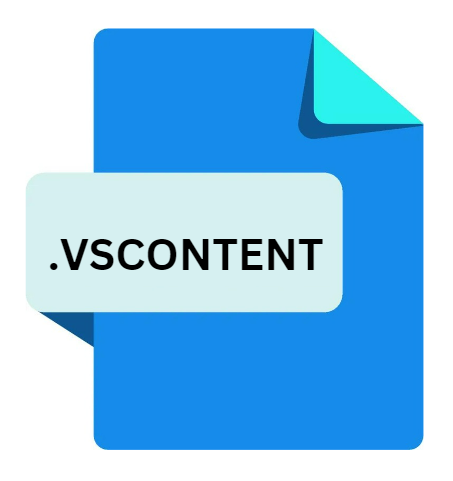.VSCONTENT File Extension

Visual Studio Content File
| Developer | Microsoft |
| Popularity | |
| Category | Data Files |
| Format | .VSCONTENT |
| Cross Platform | Update Soon |
What is an VSCONTENT file?
.VSCONTENT files serve as containers for various types of content within Visual Studio. They encapsulate resources such as images, icons, XAML files, and other project-related assets.
These files streamline the process of organizing and referencing content within a Visual Studio project, enhancing overall project management efficiency.
More Information.
Visual Studio has undergone numerous iterations since its inception, each accompanied by enhancements aimed at improving developer productivity and project management.
The introduction of .VSCONTENT files align with this overarching objective, offering developers a convenient means to organize and reference project resources seamlessly.
Initially conceived as part of Visual Studio’s evolving ecosystem, .VSCONTENT files have become integral to the development workflow of countless projects across various domains.
Origin Of This File.
The inception of .VSCONTENT files can be traced back to Microsoft’s efforts to enhance the development experience within Visual Studio.
As projects became more complex and diverse, there arose a need for a standardized approach to manage project resources efficiently.
Thus, .VSCONTENT files emerged as a solution to this challenge, providing a unified format for storing and accessing project content.
File Structure Technical Specification.
.VSCONTENT files adhere to a structured format designed to accommodate diverse types of content.
While specific details may vary depending on the content encapsulated within each file, they typically include metadata, resource identifiers, and binary data representing the actual content.
This structured approach enables Visual Studio to parse and utilize .VSCONTENT files efficiently, facilitating smooth integration with project workflows.
How to Convert the File?
Converting ‘.VSCONTENT’ files to alternative formats or structures may be necessary in certain scenarios, such as migrating projects to different development environments or integrating with external systems.
While direct conversion tools tailored specifically for ‘.VSCONTENT’ files may not be readily available, developers can employ various strategies to achieve conversion:
- Custom Scripts or Utilities: Developers can create custom scripts or utilities to parse ‘.VSCONTENT’ files and transform their content into desired formats or structures. This approach offers flexibility and customization but requires programming expertise.
- Intermediate Formats: Convert ‘.VSCONTENT’ files to intermediate formats such as JSON or CSV, which can then be further processed or imported into alternative systems or tools.
- Manual Conversion: In cases where automation is impractical or unavailable, manual conversion by inspecting and recreating content in the desired format may be necessary, albeit time-consuming.
Advantages And Disadvantages.
Advantages:
- Centralized Content Management: ‘.VSCONTENT’ files provide a centralized repository for project-related assets, streamlining content management and ensuring consistency across development environments.
- Version Control Integration: By including ‘.VSCONTENT’ files in version control systems, developers can track changes to project assets alongside source code modifications, facilitating collaboration and project maintenance.
- Enhanced Project Organization: The hierarchical structure of ‘.VSCONTENT’ files enables developers to organize content systematically, improving project clarity and navigation within Visual Studio.
Disadvantages:
- Dependency on Visual Studio: ‘.VSCONTENT’ files are tightly coupled with the Visual Studio IDE, limiting their utility outside this ecosystem and potentially hindering interoperability with alternative development tools.
- Complexity in Large Projects: In larger projects with numerous content items, managing ‘.VSCONTENT’ files can become cumbersome, necessitating careful organization and maintenance to prevent clutter and inefficiency.
How to Open VSCONTENT?
Open In Windows
- Visual Studio: ‘.VSCONTENT’ files can be directly opened in Visual Studio, Microsoft’s integrated development environment for Windows. Simply double-click on the ‘.VSCONTENT’ file, and it should automatically open in Visual Studio.
Open In Linux
- Visual Studio Code: While Visual Studio itself is not natively supported on Linux, Visual Studio Code, a lightweight code editor, offers some compatibility. Install Visual Studio Code on your Linux distribution, then open the ‘.VSCONTENT’ file using Visual Studio Code. While it may not provide full support for ‘.VSCONTENT’ files, it can still offer basic viewing and editing capabilities.
Open In MAC
- Visual Studio for Mac: If you’re using a macOS system, you can open ‘.VSCONTENT’ files in Visual Studio for Mac, a version of Visual Studio optimized for macOS development. Simply double-click on the ‘.VSCONTENT’ file, and it should open within Visual Studio for Mac.
Open In Android
- Third-Party IDEs: While Android development primarily revolves around Android Studio, other third-party integrated development environments may offer limited support for ‘.VSCONTENT’ files. Look for IDEs compatible with Android development on the Google Play Store or third-party websites and check if they provide any support for ‘.VSCONTENT’ files.
Open In IOS
- Third-Party IDEs: Similar to Android, iOS development typically centers around Apple’s Xcode IDE. However, third-party IDEs may offer partial support for ‘.VSCONTENT’ files. Explore alternative iOS development environments available on the App Store or through other sources and see if they support opening ‘.VSCONTENT’ files.













